Kibok Lee
Soft Task-Aware Routing of Experts for Equivariant Representation Learning
Oct 31, 2025Abstract:Equivariant representation learning aims to capture variations induced by input transformations in the representation space, whereas invariant representation learning encodes semantic information by disregarding such transformations. Recent studies have shown that jointly learning both types of representations is often beneficial for downstream tasks, typically by employing separate projection heads. However, this design overlooks information shared between invariant and equivariant learning, which leads to redundant feature learning and inefficient use of model capacity. To address this, we introduce Soft Task-Aware Routing (STAR), a routing strategy for projection heads that models them as experts. STAR induces the experts to specialize in capturing either shared or task-specific information, thereby reducing redundant feature learning. We validate this effect by observing lower canonical correlations between invariant and equivariant embeddings. Experimental results show consistent improvements across diverse transfer learning tasks. The code is available at https://github.com/YonseiML/star.
On the Similarities of Embeddings in Contrastive Learning
Jun 11, 2025Abstract:Contrastive learning (CL) operates on a simple yet effective principle: embeddings of positive pairs are pulled together, while those of negative pairs are pushed apart. Although various forms of contrastive loss have been proposed and analyzed from different perspectives, prior works lack a comprehensive framework that systematically explains a broad class of these objectives. In this paper, we present a unified framework for understanding CL, which is based on analyzing the cosine similarity between embeddings of positive and negative pairs. In full-batch settings, we show that perfect alignment of positive pairs is unattainable when similarities of negative pairs fall below a certain threshold, and that this misalignment can be alleviated by incorporating within-view negative pairs. In mini-batch settings, we demonstrate that smaller batch sizes incur stronger separation among negative pairs within batches, which leads to higher variance in similarities of negative pairs. To address this limitation of mini-batch CL, we introduce an auxiliary loss term that reduces the variance of similarities of negative pairs in CL. Empirical results demonstrate that incorporating the proposed loss consistently improves the performance of CL methods in small-batch training.
* contrastive learning, representation learning, embedding, similarity, negative pair, positive pair
A Theoretical Framework for Preventing Class Collapse in Supervised Contrastive Learning
Mar 11, 2025Abstract:Supervised contrastive learning (SupCL) has emerged as a prominent approach in representation learning, leveraging both supervised and self-supervised losses. However, achieving an optimal balance between these losses is challenging; failing to do so can lead to class collapse, reducing discrimination among individual embeddings in the same class. In this paper, we present theoretically grounded guidelines for SupCL to prevent class collapse in learned representations. Specifically, we introduce the Simplex-to-Simplex Embedding Model (SSEM), a theoretical framework that models various embedding structures, including all embeddings that minimize the supervised contrastive loss. Through SSEM, we analyze how hyperparameters affect learned representations, offering practical guidelines for hyperparameter selection to mitigate the risk of class collapse. Our theoretical findings are supported by empirical results across synthetic and real-world datasets.
To Predict or Not To Predict? Proportionally Masked Autoencoders for Tabular Data Imputation
Dec 26, 2024Abstract:Masked autoencoders (MAEs) have recently demonstrated effectiveness in tabular data imputation. However, due to the inherent heterogeneity of tabular data, the uniform random masking strategy commonly used in MAEs can disrupt the distribution of missingness, leading to suboptimal performance. To address this, we propose a proportional masking strategy for MAEs. Specifically, we first compute the statistics of missingness based on the observed proportions in the dataset, and then generate masks that align with these statistics, ensuring that the distribution of missingness is preserved after masking. Furthermore, we argue that simple MLP-based token mixing offers competitive or often superior performance compared to attention mechanisms while being more computationally efficient, especially in the tabular domain with the inherent heterogeneity. Experimental results validate the effectiveness of the proposed proportional masking strategy across various missing data patterns in tabular datasets. Code is available at: \url{https://github.com/normal-kim/PMAE}.
Partial Channel Dependence with Channel Masks for Time Series Foundation Models
Oct 30, 2024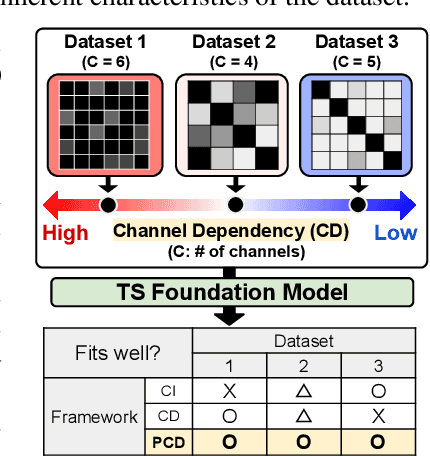

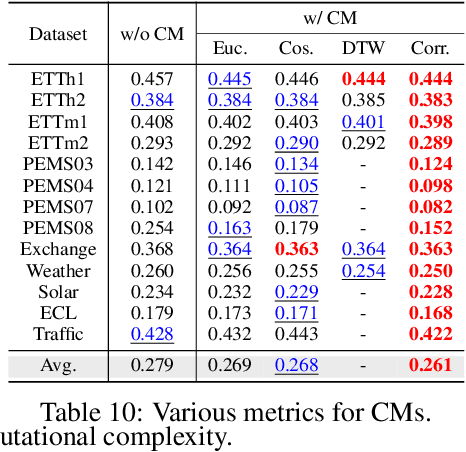
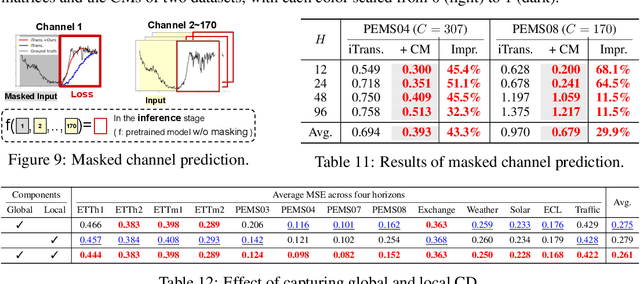
Abstract:Recent advancements in foundation models have been successfully extended to the time series (TS) domain, facilitated by the emergence of large-scale TS datasets. However, previous efforts have primarily focused on designing model architectures to address explicit heterogeneity among datasets such as various numbers of channels, while often overlooking implicit heterogeneity such as varying dependencies between channels. In this work, we introduce the concept of partial channel dependence (PCD), which enables a more sophisticated adjustment of channel dependencies based on dataset-specific information. To achieve PCD, we propose a channel mask that captures the relationships between channels within a dataset using two key components: 1) a correlation matrix that encodes relative dependencies between channels, and 2) domain parameters that learn the absolute dependencies specific to each dataset, refining the correlation matrix. We validate the effectiveness of PCD across four tasks in TS including forecasting, classification, imputation, and anomaly detection, under diverse settings, including few-shot and zero-shot scenarios with both TS foundation models and single-task models. Code is available at https://github.com/seunghan96/CM.
Sequential Order-Robust Mamba for Time Series Forecasting
Oct 30, 2024Abstract:Mamba has recently emerged as a promising alternative to Transformers, offering near-linear complexity in processing sequential data. However, while channels in time series (TS) data have no specific order in general, recent studies have adopted Mamba to capture channel dependencies (CD) in TS, introducing a sequential order bias. To address this issue, we propose SOR-Mamba, a TS forecasting method that 1) incorporates a regularization strategy to minimize the discrepancy between two embedding vectors generated from data with reversed channel orders, thereby enhancing robustness to channel order, and 2) eliminates the 1D-convolution originally designed to capture local information in sequential data. Furthermore, we introduce channel correlation modeling (CCM), a pretraining task aimed at preserving correlations between channels from the data space to the latent space in order to enhance the ability to capture CD. Extensive experiments demonstrate the efficacy of the proposed method across standard and transfer learning scenarios. Code is available at https://github.com/seunghan96/SOR-Mamba.
ANT: Adaptive Noise Schedule for Time Series Diffusion Models
Oct 18, 2024Abstract:Advances in diffusion models for generative artificial intelligence have recently propagated to the time series (TS) domain, demonstrating state-of-the-art performance on various tasks. However, prior works on TS diffusion models often borrow the framework of existing works proposed in other domains without considering the characteristics of TS data, leading to suboptimal performance. In this work, we propose Adaptive Noise schedule for Time series diffusion models (ANT), which automatically predetermines proper noise schedules for given TS datasets based on their statistics representing non-stationarity. Our intuition is that an optimal noise schedule should satisfy the following desiderata: 1) It linearly reduces the non-stationarity of TS data so that all diffusion steps are equally meaningful, 2) the data is corrupted to the random noise at the final step, and 3) the number of steps is sufficiently large. The proposed method is practical for use in that it eliminates the necessity of finding the optimal noise schedule with a small additional cost to compute the statistics for given datasets, which can be done offline before training. We validate the effectiveness of our method across various tasks, including TS forecasting, refinement, and generation, on datasets from diverse domains. Code is available at this repository: https://github.com/seunghan96/ANT.
On the Effectiveness of Supervision in Asymmetric Non-Contrastive Learning
Jun 16, 2024Abstract:Supervised contrastive representation learning has been shown to be effective in various transfer learning scenarios. However, while asymmetric non-contrastive learning (ANCL) often outperforms its contrastive learning counterpart in self-supervised representation learning, the extension of ANCL to supervised scenarios is less explored. To bridge the gap, we study ANCL for supervised representation learning, coined SupSiam and SupBYOL, leveraging labels in ANCL to achieve better representations. The proposed supervised ANCL framework improves representation learning while avoiding collapse. Our analysis reveals that providing supervision to ANCL reduces intra-class variance, and the contribution of supervision should be adjusted to achieve the best performance. Experiments demonstrate the superiority of supervised ANCL across various datasets and tasks. The code is available at: https://github.com/JH-Oh-23/Sup-ANCL.
Rethinking Open-World Semi-Supervised Learning: Distribution Mismatch and Inductive Inference
May 31, 2024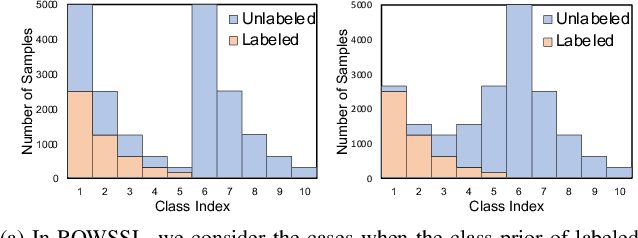
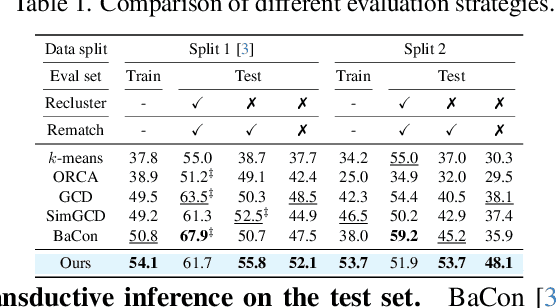
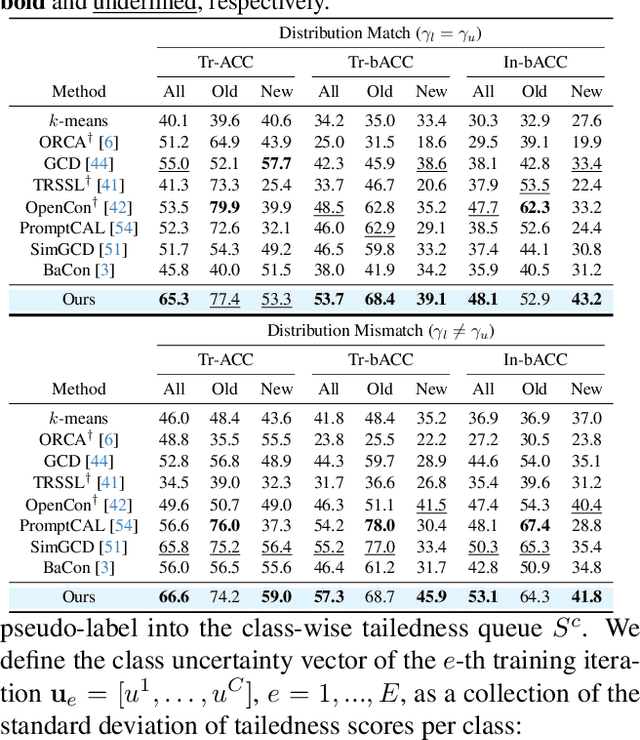

Abstract:Open-world semi-supervised learning (OWSSL) extends conventional semi-supervised learning to open-world scenarios by taking account of novel categories in unlabeled datasets. Despite the recent advancements in OWSSL, the success often relies on the assumptions that 1) labeled and unlabeled datasets share the same balanced class prior distribution, which does not generally hold in real-world applications, and 2) unlabeled training datasets are utilized for evaluation, where such transductive inference might not adequately address challenges in the wild. In this paper, we aim to generalize OWSSL by addressing them. Our work suggests that practical OWSSL may require different training settings, evaluation methods, and learning strategies compared to those prevalent in the existing literature.
Learning to Embed Time Series Patches Independently
Dec 27, 2023Abstract:Masked time series modeling has recently gained much attention as a self-supervised representation learning strategy for time series. Inspired by masked image modeling in computer vision, recent works first patchify and partially mask out time series, and then train Transformers to capture the dependencies between patches by predicting masked patches from unmasked patches. However, we argue that capturing such patch dependencies might not be an optimal strategy for time series representation learning; rather, learning to embed patches independently results in better time series representations. Specifically, we propose to use 1) the simple patch reconstruction task, which autoencode each patch without looking at other patches, and 2) the simple patch-wise MLP that embeds each patch independently. In addition, we introduce complementary contrastive learning to hierarchically capture adjacent time series information efficiently. Our proposed method improves time series forecasting and classification performance compared to state-of-the-art Transformer-based models, while it is more efficient in terms of the number of parameters and training/inference time. Code is available at this repository: https://github.com/seunghan96/pits.
 Add to Chrome
Add to Chrome Add to Firefox
Add to Firefox Add to Edge
Add to Edge